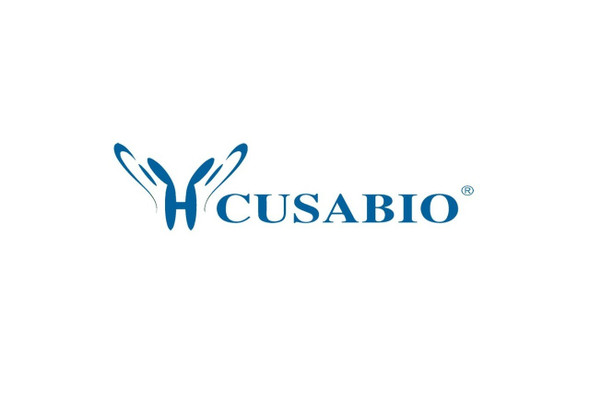Cusabio Human Recombinants
Recombinant Human Fibroblast growth factor 1 (FGF1) | CSB-EP008615HUc7
- SKU:
- CSB-EP008615HUc7
- Availability:
- 13 - 23 Working Days
Description
Recombinant Human Fibroblast growth factor 1 (FGF1) | CSB-EP008615HUc7 | Cusabio
Alternative Name(s): Acidic fibroblast growth factor(aFGF) (Endothelial cell growth factor) (ECGF) (Heparin-binding growth factor 1) (HBGF-1 ) (FGF-1) (FGFA)
Gene Names: FGF1
Research Areas: Signal Transduction
Organism: Homo sapiens (Human)
AA Sequence: FNLPPGNYKKPKLLYCSNGGHFLRILPDGTVDGTRDRSDQHIQLQLSAESVGEVYIKSTETGQYLAMDTDGLLYGSQTPNEECLFLERLEENHYNTYISKKHAEKNWFVGLKKNGSCKRGPRTHYGQKAILFLPLPVSSD
Source: E.coli
Tag Info: C-terminal 6xHis-tagged
Expression Region: 16-155aa
Sequence Info: Full Length of Mature Protein
MW: 17.8 kDa
Purity: Greater than 85% as determined by SDS-PAGE.
Relevance: Plays an important role in the regulation of cell survival, cell division, angiogenesis, cell differentiation and cell migration. Functions as potent mitogen in vitro. Acts as a ligand for FGFR1 and integrins. Binds to FGFR1 in the presence of heparin leading to FGFR1 dimerization and activation via sequential autophosphorylation on tyrosine residues which act as docking sites for interacting proteins, leading to the activation of several signaling cascades. Binds to integrin ITGAV:ITGB3. Its binding to integrin, subsequent ternary complex formation with integrin and FGFR1, and the recruitment of PTPN11 to the complex are essential for FGF1 signaling. Induces the phosphorylation and activation of FGFR1, FRS2, MAPK3/ERK1, MAPK1/ERK2 and AKT1 . Can induce angiogenesis.
Reference: "Complete sequencing and characterization of 21,243 full-length human cDNAs." Ota T., Suzuki Y., Nishikawa T., Otsuki T., Sugiyama T., Irie R., Wakamatsu A., Hayashi K., Sato H., Nagai K., Kimura K., Makita H., Sekine M., Obayashi M., Nishi T., Shibahara T., Tanaka T., Ishii S. Sugano S. Nat. Genet. 36:40-45(2004)
Storage: The shelf life is related to many factors, storage state, buffer ingredients, storage temperature and the stability of the protein itself. Generally, the shelf life of liquid form is 6 months at -20?/-80?. The shelf life of lyophilized form is 12 months at -20?/-80?.
Notes: Repeated freezing and thawing is not recommended. Store working aliquots at 4? for up to one week.
Function: Plays an important role in the regulation of cell survival, cell division, angiogenesis, cell differentiation and cell migration. Functions as potent mitogen in vitro. Acts as a ligand for FGFR1 and integrins. Binds to FGFR1 in the presence of heparin leading to FGFR1 dimerization and activation via sequential autophosphorylation on tyrosine residues which act as docking sites for interacting proteins, leading to the activation of several signaling cascades. Binds to integrin ITGAV
Involvement in disease:
Subcellular Location: Secreted, Cytoplasm, Cytoplasm, cell cortex, Cytoplasm, cytosol, Nucleus
Protein Families: Heparin-binding growth factors family
Tissue Specificity: Predominantly expressed in kidney and brain. Detected at much lower levels in heart and skeletal muscle.
Paythway: Hipposignalingpathway
Form: Liquid or Lyophilized powder
Buffer: If the delivery form is liquid, the default storage buffer is Tris/PBS-based buffer, 5%-50% glycerol. If the delivery form is lyophilized powder, the buffer before lyophilization is Tris/PBS-based buffer, 6% Trehalose, pH 8.0.
Reconstitution: We recommend that this vial be briefly centrifuged prior to opening to bring the contents to the bottom. Please reconstitute protein in deionized sterile water to a concentration of 0.1-1.0 mg/mL.We recommend to add 5-50% of glycerol (final concentration) and aliquot for long-term storage at -20?/-80?. Our default final concentration of glycerol is 50%. Customers could use it as reference.
Uniprot ID: P05230
HGNC Database Link: HGNC
UniGene Database Link: UniGene
KEGG Database Link: KEGG
STRING Database Link: STRING
OMIM Database Link: OMIM










